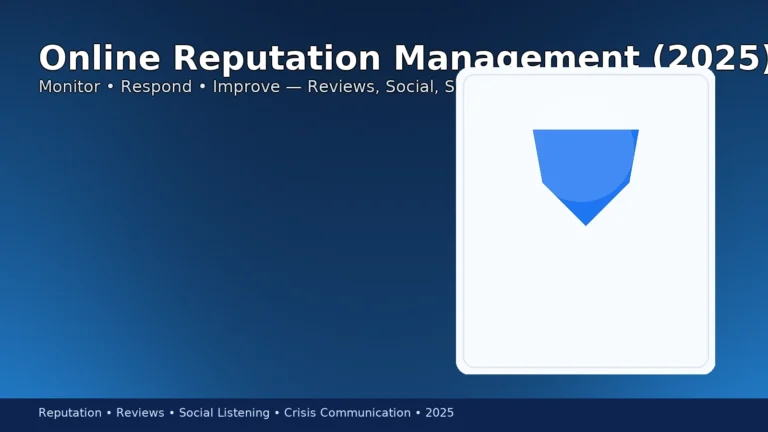Guide • Trust & Growth
Online Reputation Management (2025): 21 Proven Tactics to Protect & Grow Your Brand

This practical playbook explains Online Reputation Management—how to monitor, respond, and improve brand perception using brand monitoring, review management, social listening, crisis communication, and a durable online PR strategy.
Table of Contents
- Post Overview
- Key Features (21 Tactics)
- Why Choose Our Product
- Call-to-Action (CTA)
- Motivational Note & Resources
Helpful references:
Google Business Profile Help,
Yelp Support,
Trustpilot Guidance,
BBB Standards,
Meta Community Standards.
Post Overview
Strong Online Reputation Management (ORM) protects revenue, lowers acquisition costs, and compounds trust.
In 2025, search results, local listings, and social proof are often your first impression—long before a salesperson
speaks to a prospect. This guide shows how to build a repeatable ORM system: continuous brand monitoring,
fast high-quality responses, smart escalation, and positive content that earns coverage and rankings.
and publishing assets that demonstrate credibility. It’s not “hiding” everything—it’s earning the story you deserve.
Key Features (21 Tactics)
Use these ethical, durable tactics to improve Reputation Management. H3 sections are mini playbooks you can act on today.
1) Baseline Audit
Google your brand, products, and executives. Capture page-1 results, star ratings, and common questions. This becomes your ORM baseline.
2) Brand Monitoring
Track mentions across search, news, and social. Set alerts for names, products, and competitors. This is the backbone of Reputation Management.
3) Social Listening
Follow keywords and hashtags; tag sentiment and themes. Turn insights into content and product fixes.
4) Review Management
Centralize reviews from Google, Yelp, and vertical platforms. Respond within 24–48 hours, thank positives, and route negatives to support.
5) Listings Hygiene
Keep NAP (name, address, phone) consistent across directories. Correct categories, add photos, and post updates.
6) Response Playbooks
Publish internal scripts for common scenarios—shipping delay, refund, warranty, service outage—to keep tone consistent and helpful.
7) Crisis Communication
Create a small, cross-functional team with clear thresholds for escalation, approvals, and public statements.
8) Own Your SERP
Build out your homepage, about, newsroom, careers, and FAQs. Publish E-E-A-T signals (expertise, experience, author bios).
9) Online PR Strategy
Pitch expert commentary, case studies, and data stories. Earn coverage that pushes positives onto page 1.
10) Customer Story Engine
Collect testimonials and long-form case studies. Add schema markup to improve appearance in search.
11) Product Q&A & Knowledge Base
Proactively answer common concerns with articles and videos. Link these in review replies to resolve doubts.
12) Employee Advocacy
Encourage staff to share milestones and community events; provide safe-sharing guidelines.
13) Local SEO for Reputation
Optimize Google Business Profiles; use attributes, services, and messaging; post weekly updates.
14) Proactive Ask for Reviews
Time your ask after a successful moment. Keep it optional, honest, and policy-compliant.
15) Escalation & Remediation
For serious issues, move to private channels quickly, document facts, and return with a public resolution summary.
16) Executive Presence
Maintain professional profiles for founders/leaders (LinkedIn, site bio). Share transparent updates during incidents.
17) Community Investment
Support local initiatives and publish recaps. Reputation is built by consistent action, not slogans.
18) Legal & Policy Alignment
Know platform policies and local laws. Use formal removal requests only for valid violations—never as a first resort.
19) Measurement & KPIs
Track share of positive results on page 1, average star rating, response time, and resolution rate.
20) Quarterly Review Ops
Every quarter, refresh your ORM roadmap and close loops with product and support teams.
21) Automation with Care
Use templates and alerts, but keep human review for anything sensitive. Authenticity wins in Reputation Management.
Fast 30-minute weekly loop:
- Scan alerts and social listening dashboards.
- Reply to new reviews and surface patterns.
- Publish one proof asset (testimonial, fix log, or FAQ).
- Log KPIs and share a 3-bullet internal update.
Why Choose Our Product
We turn Reputation Management into a repeatable system:
brand monitoring dashboards, review management workflows, social listening insights,
crisis communication protocols, and a proactive online PR strategy that steadily earns trust.
- Audit & roadmap: baseline your SERP, reviews, and social sentiment with prioritized fixes.
- Response ops: templates, tone guides, and SLAs that reduce risk and improve CSAT.
- Content engine: case studies, explainers, media kits, and schema for stronger visibility.
- Reporting: live dashboards and quarterly business reviews tied to revenue outcomes.
Call-to-Action (CTA)
Ready to protect and grow your brand? Get a tailored Reputation Management plan—complete audit, playbooks, and a 90-day execution calendar.
We follow platform policies and consumer-review guidelines—no fake reviews, no astroturfing.
Motivational Note & Resources
Trust compounds. A disciplined Reputation Management habit—listen, respond, improve—turns today’s feedback
into tomorrow’s testimonials. Keep promises small and consistent, and your search results and reviews will tell the story.
Helpful Resources
- Google Business Profile — support.google.com/business
- Trustpilot Guidance — trustpilot.com
- Yelp Support — help.yelp.com
- Better Business Bureau — bbb.org
- Meta Community Standards — transparency.fb.com